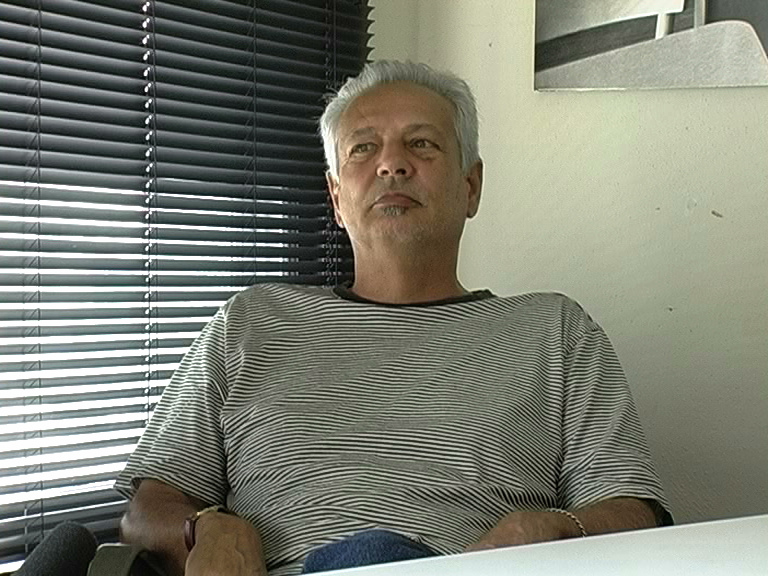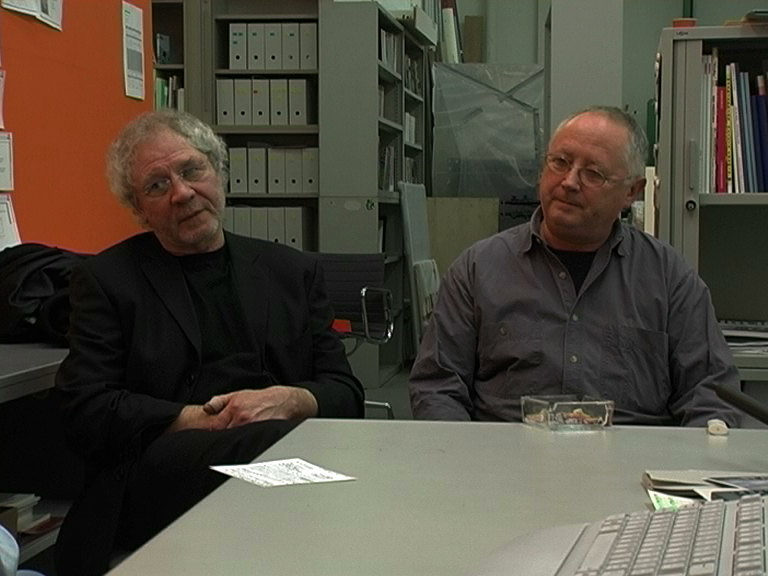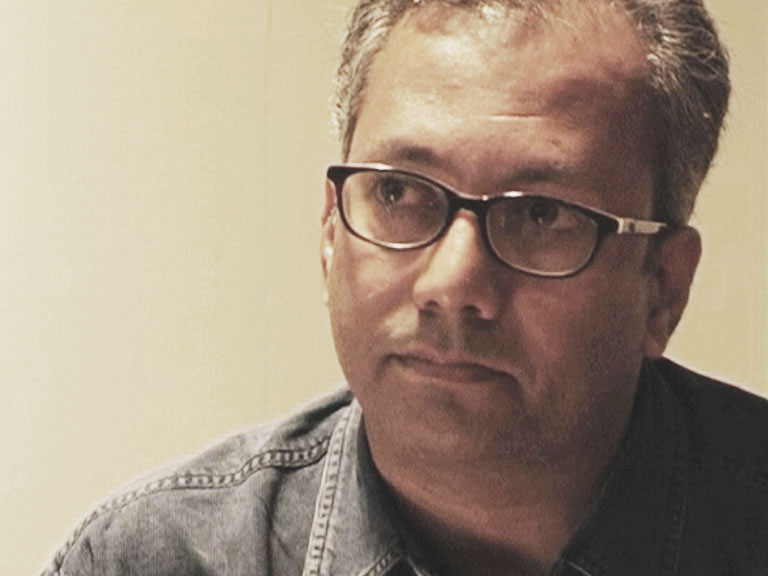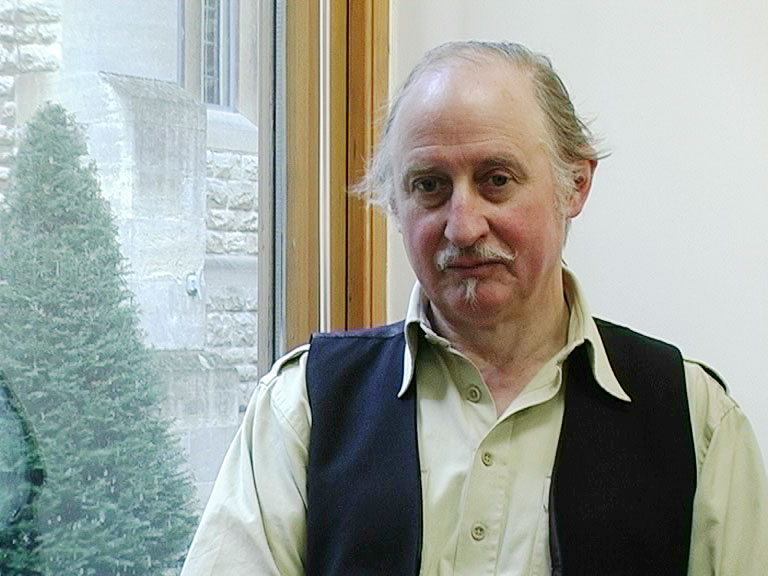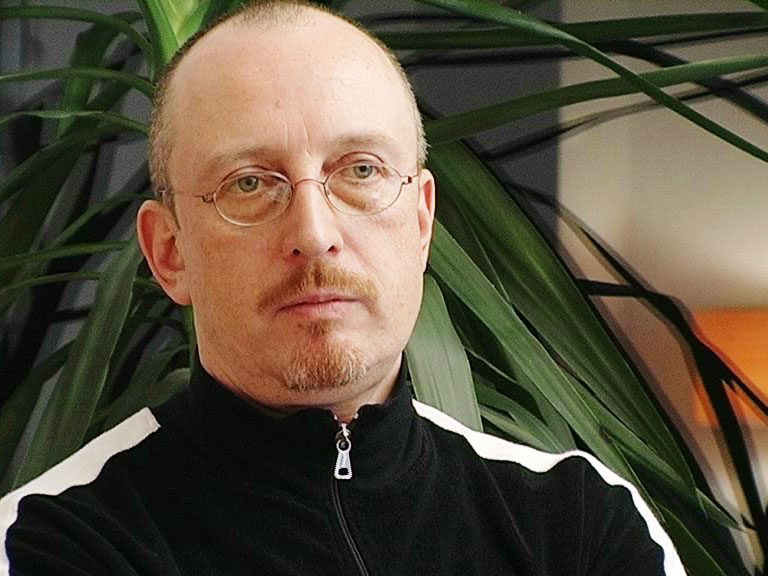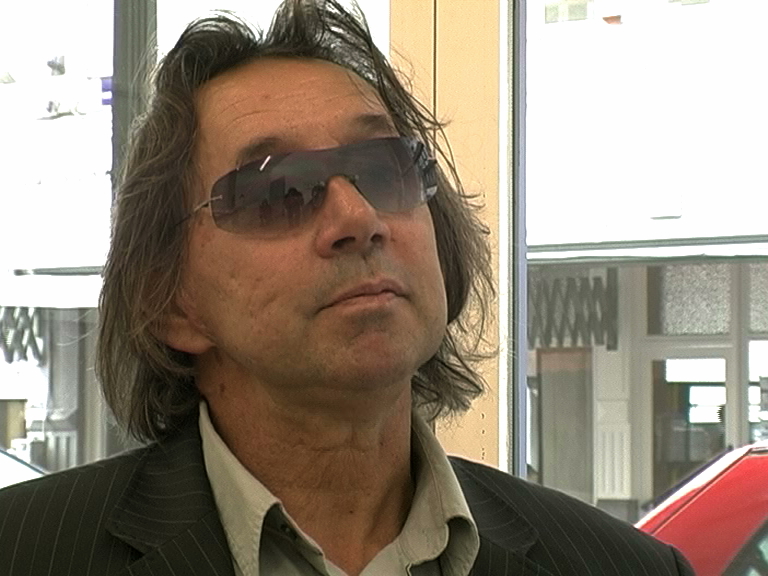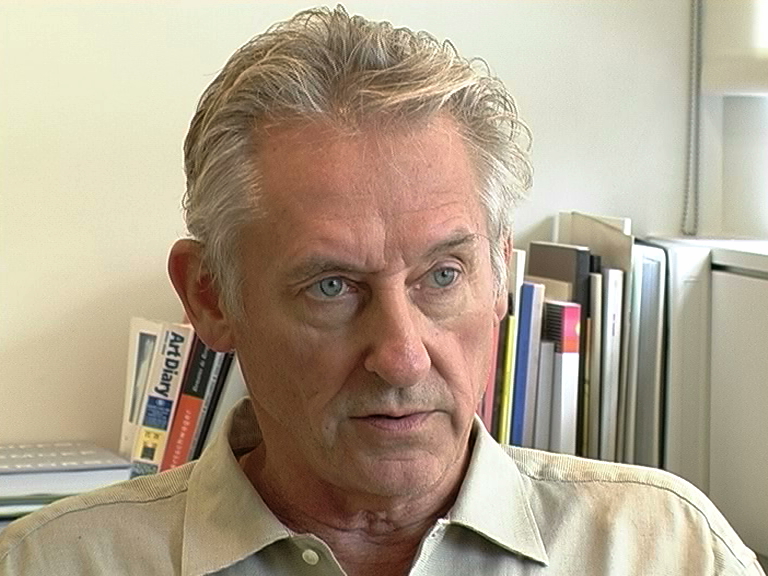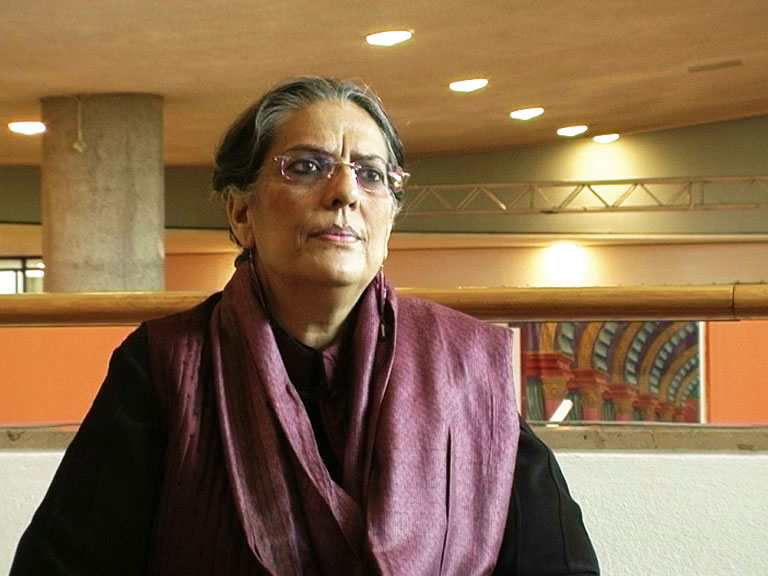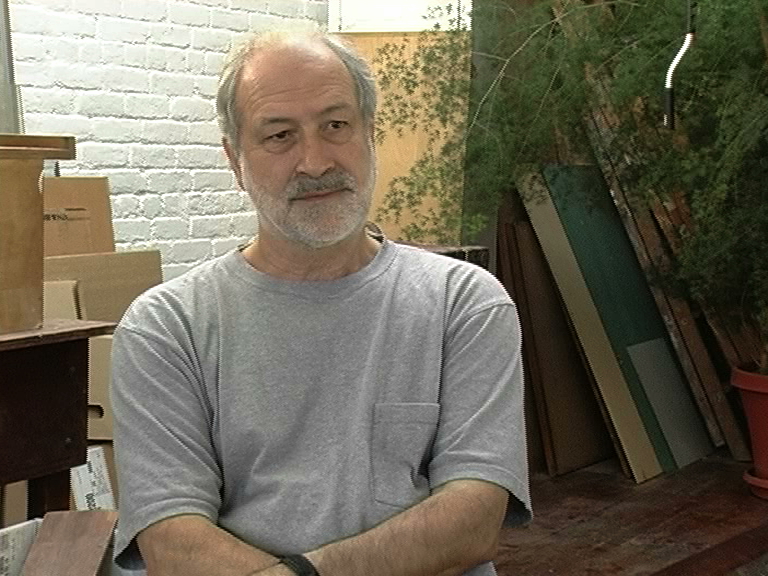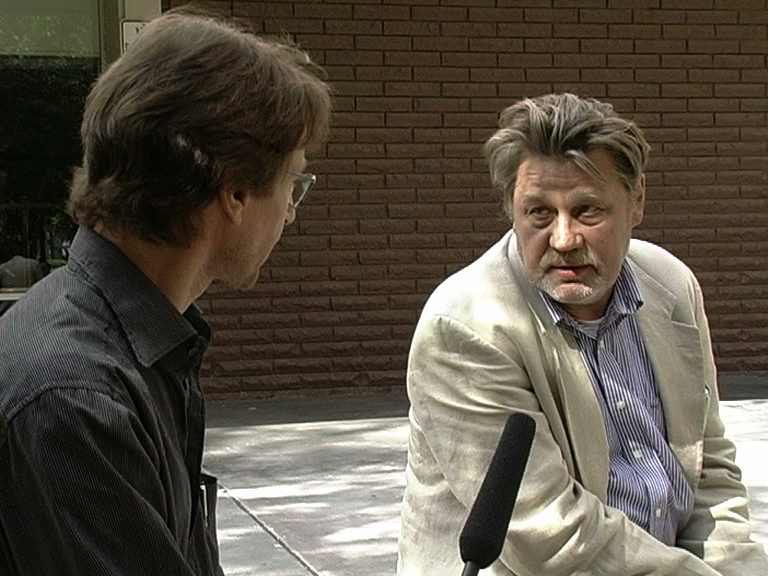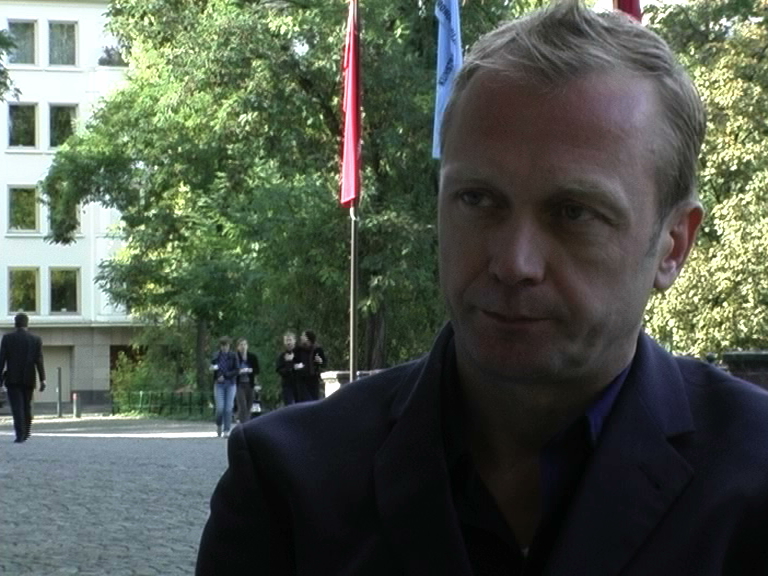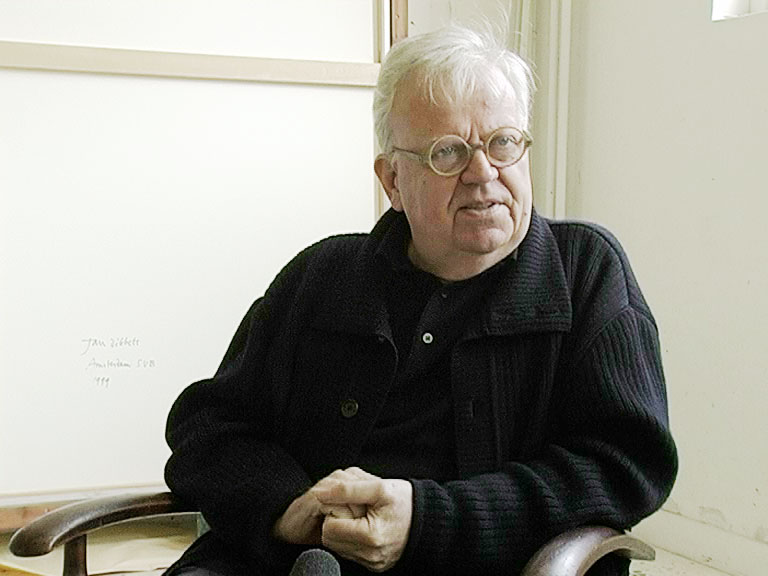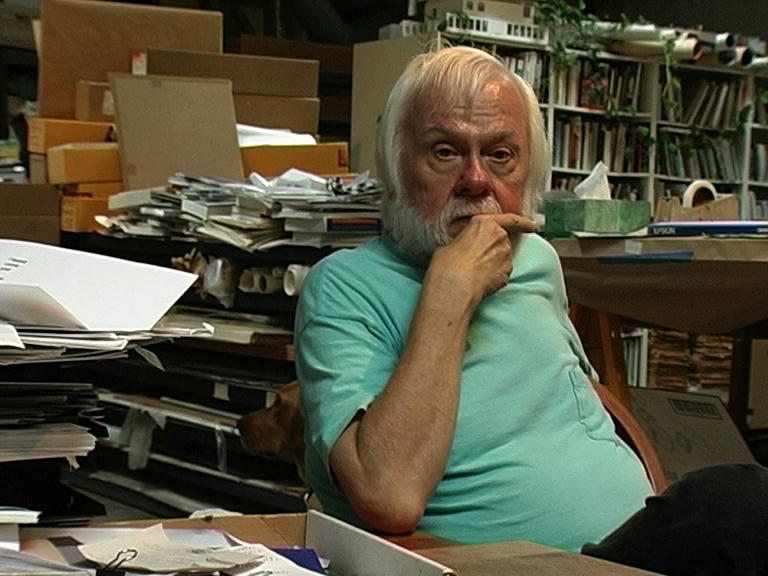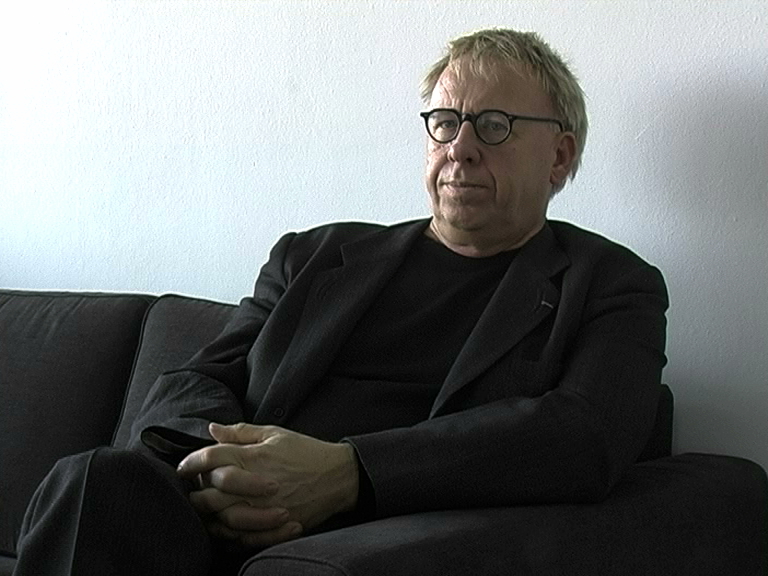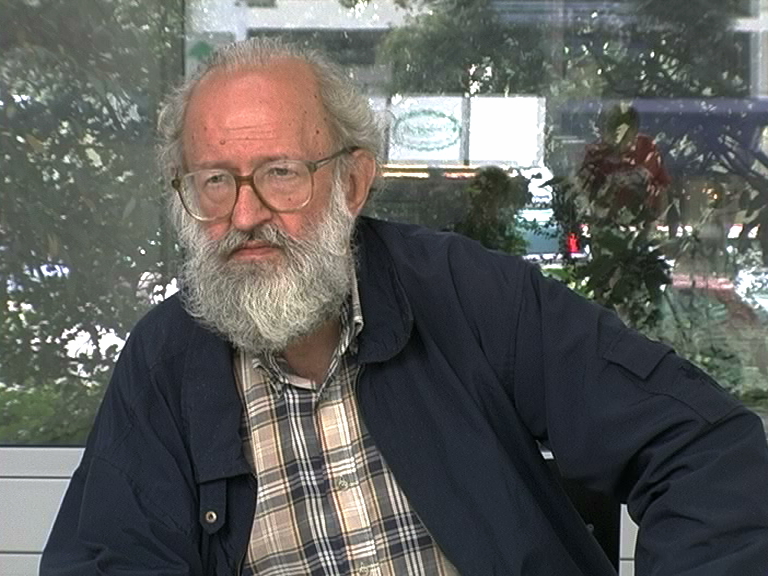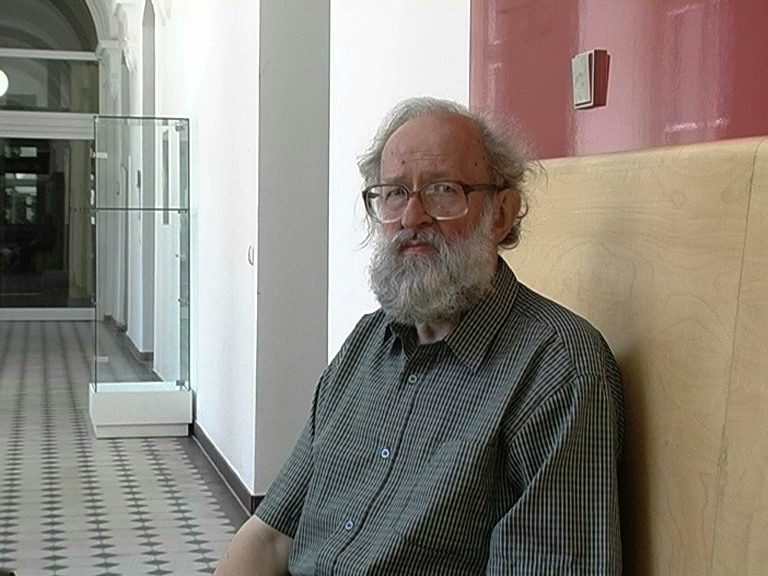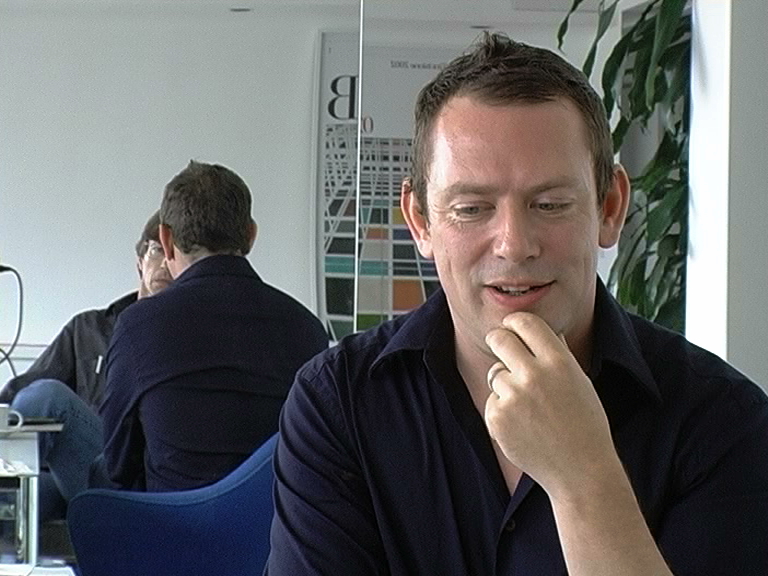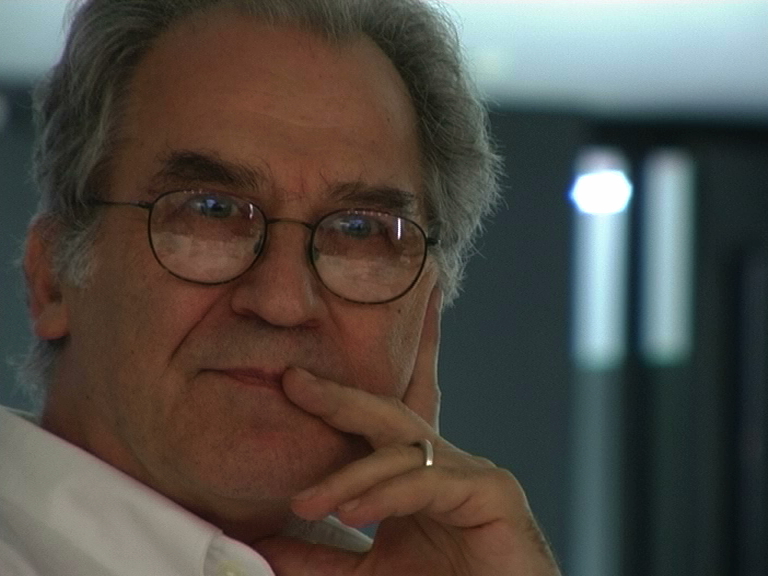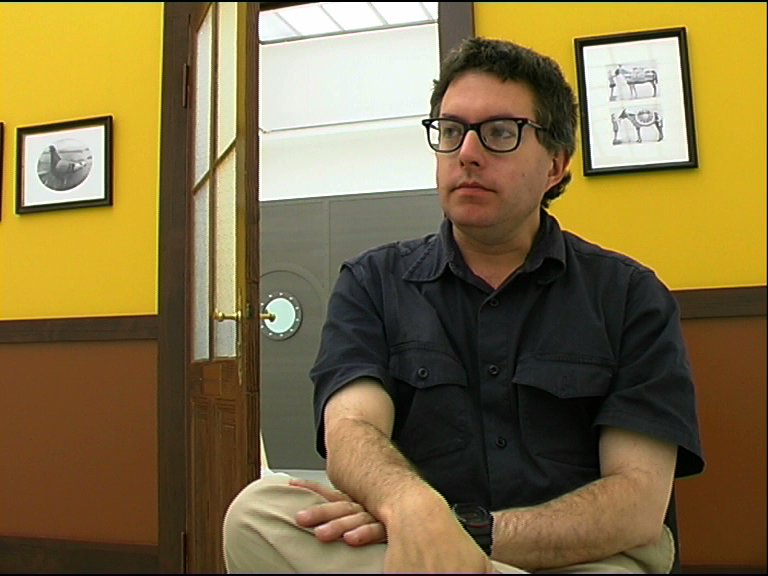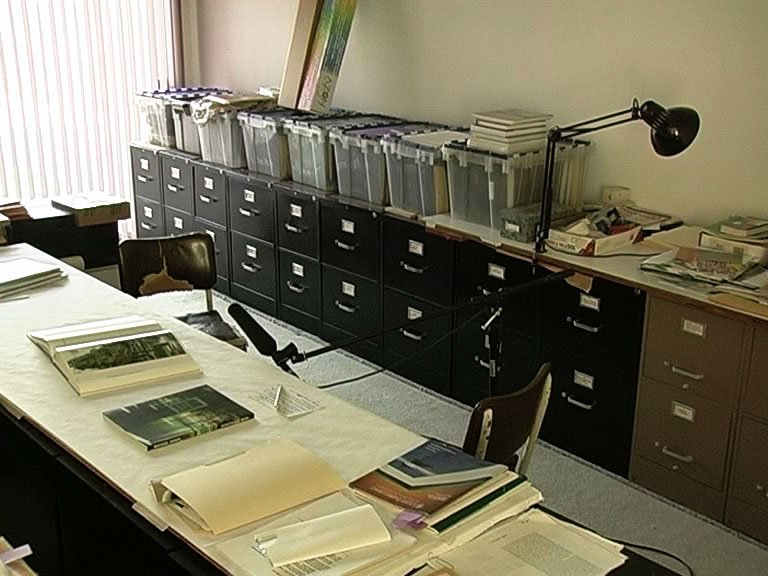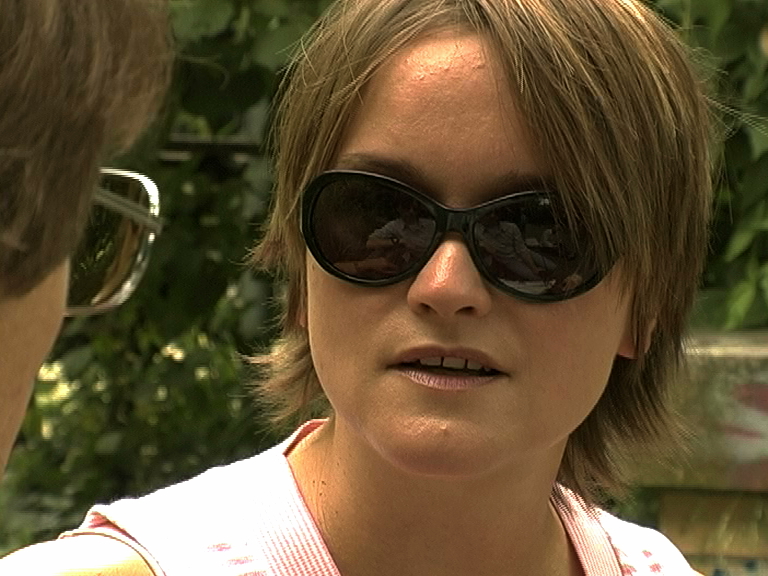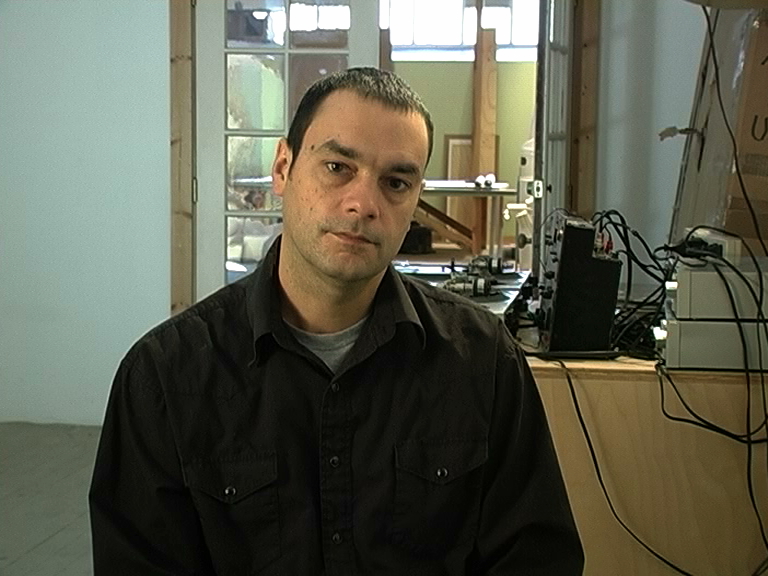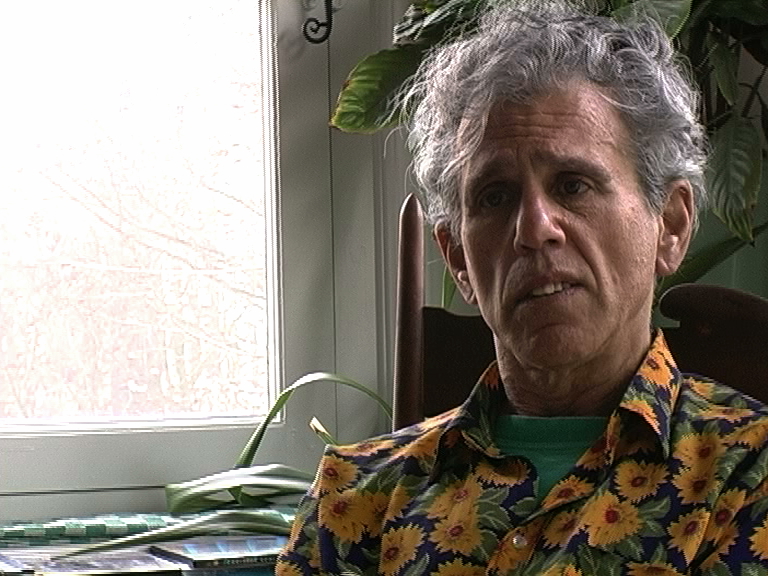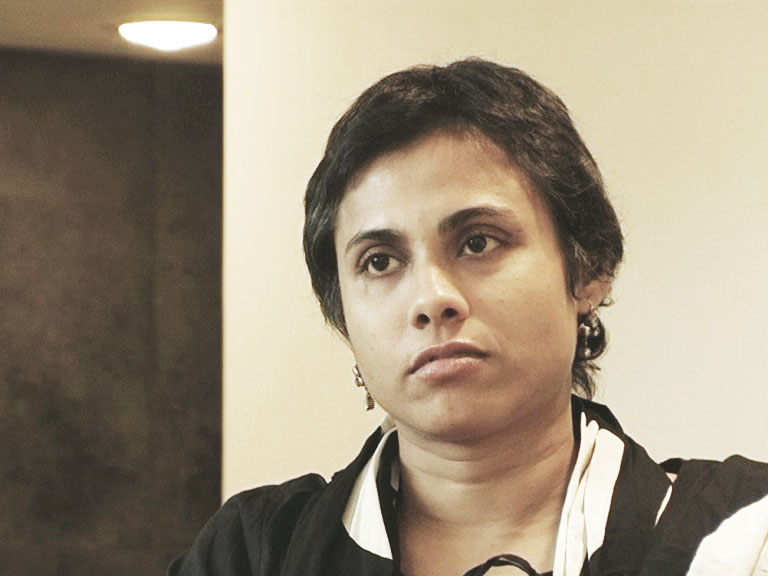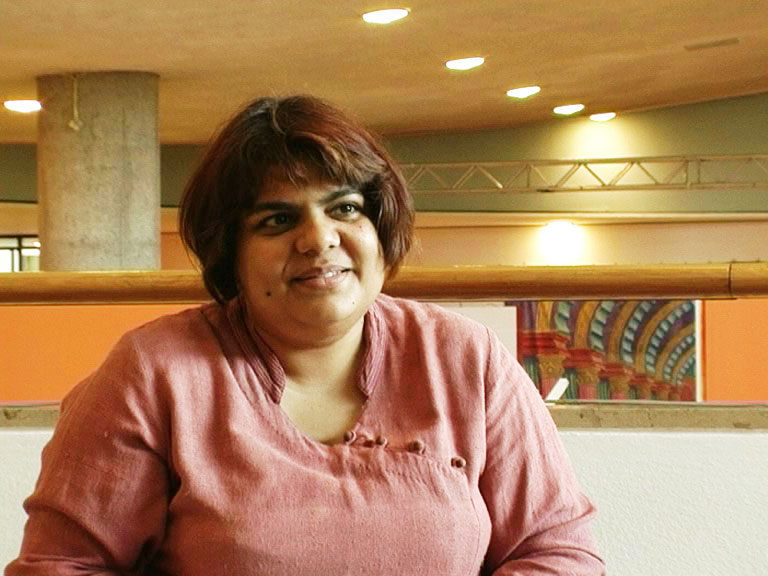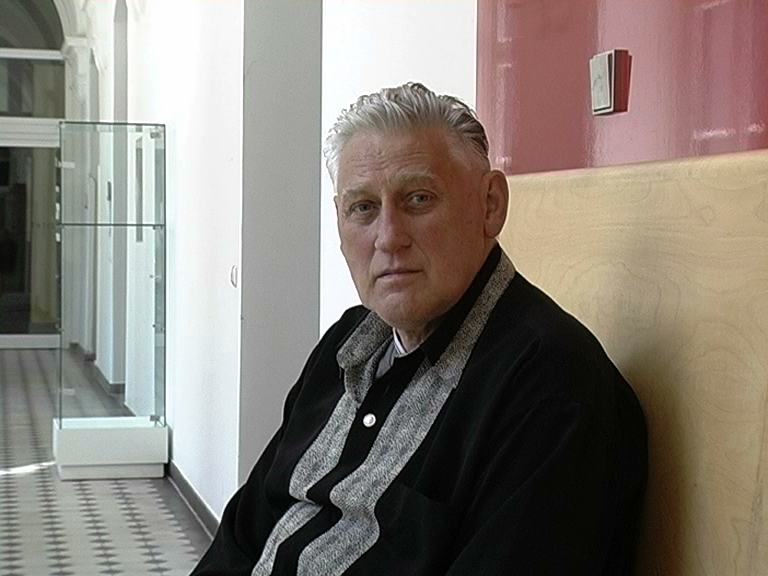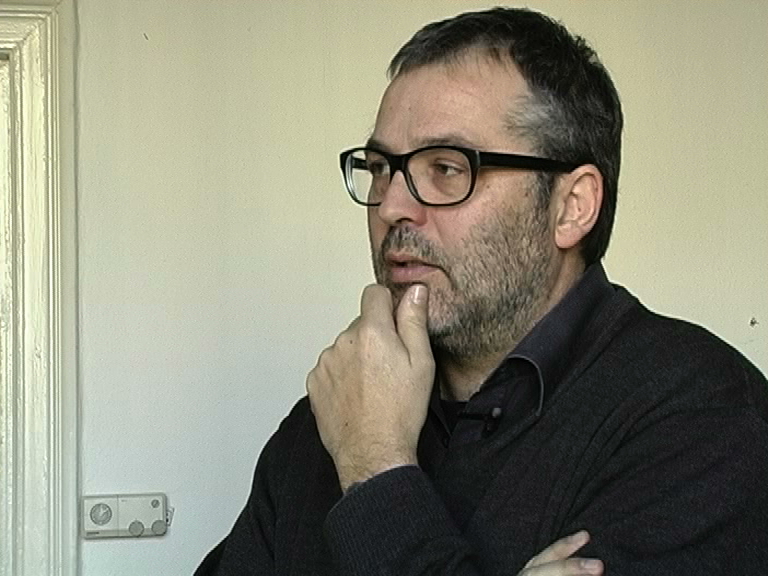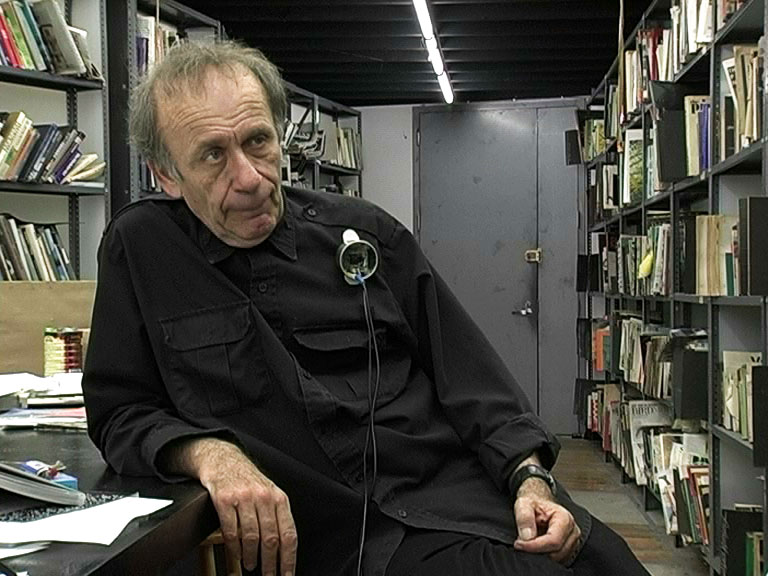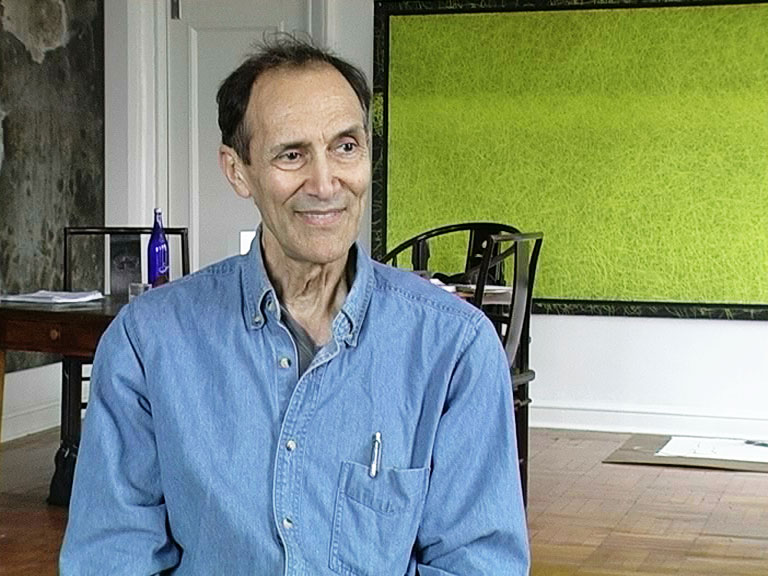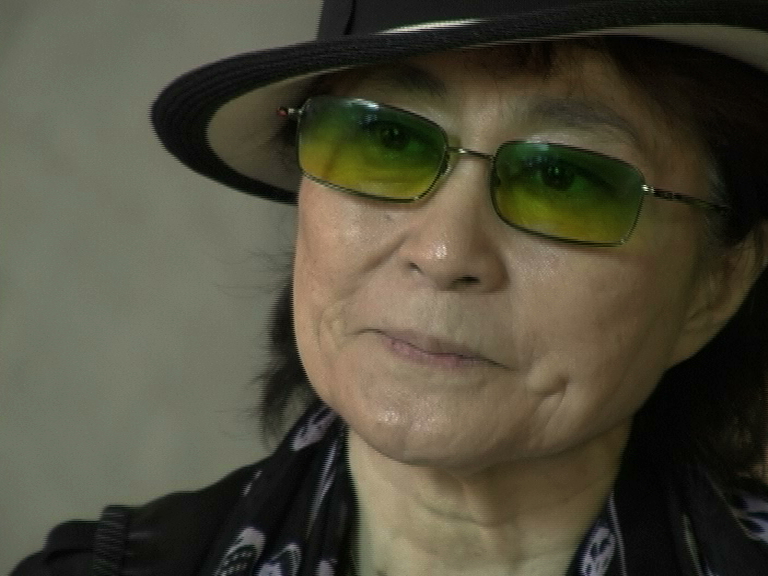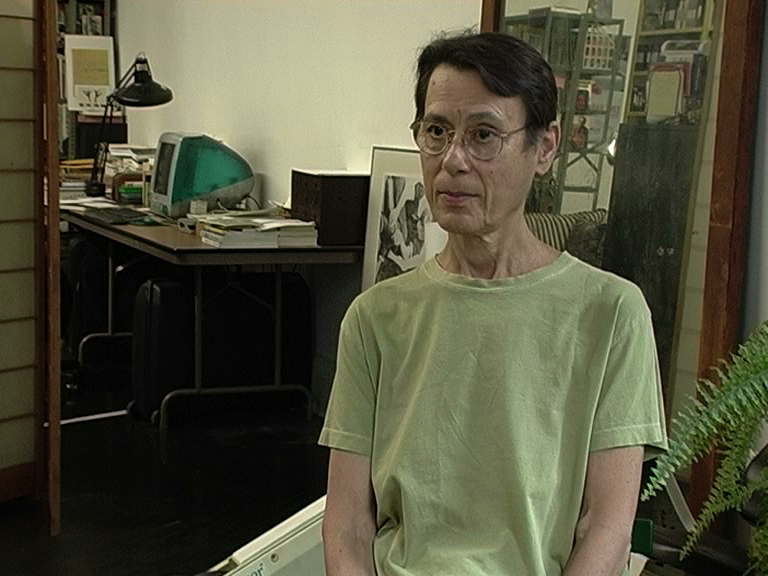S. R.: Wir sind zu Gast im Studio von Jan Dibbets in Amsterdam, am 21. März 2005. First of all I want to ask you, shall we speak in English or do you prefer to speak in German?
J.D.: Well, you are German, so we can do it in German, but if you prefer English, no problem. But the problem is that if we do it in English, as my experience in a long, long time that in any programme where numbers of artists are questioned, that especially the American artists always come out much more intelligent than anybody else because they speak their natural language. They have a big advantage on everybody who tries to express himself, clumsy but as well as he can, and they do it naturally. We can do it in English, but we know already that the English people are ahead of us in expressing their meanings. So, let´s speak English, no problem, let’s try English, let’s say it that way.
S.R.: First of all I want to mention a work you did for the Gerry Schum video gallery. It was a TV as a fireplace. How did you come to this very important work?
J.D.: In the first place there was a lot of thinking around, and everybody was trying to escape from traditional ways of making art, traditional ways of expressing yourself in art; this was a big issue. Everybody, every serious artist was digging for gold; it’s almost forgotten right now, but photography didn’t exist in the art, it was something hated; video was a new medium, but in art it didn’t exist. But nevertheless, anything which didn’t exist in the art was interesting for the artist, that was very important. So, trying to imagine what a video could be brought me to the point that actually it expresses something which is not there, and that brought me to the fireplace and the TV as a fireplace for everybody, sitting at the TV. The TV was there but the fireplace was missing. So, this was a good combination.
S.R.: And it was a big chance that it was broadcasted in German Television.
J.D.: Well, because of the craziness of the ideas there was also a sort of openness for the conservative media. They had no idea what they were broadcasting actually, but they were willing to do it because they felt that there was something serious behind it but they couldn’t have it. I think today it would be impossible to try to sell something like that to the TV, because they would say „go away, there’s too much of it“. But at that time it didn’t exist, that’s the difference.
S.R.: Let’s switch to another important exhibition, “Audiovisuelle Dokumentation” im Haus Lange, 1970 – if I researched it right you had a whole different field of works there. But once you said in an interview it’s not the point of the documentation alone. What did you mean with that?
J.D.: These works were, they are completely unknown by now, nobody knows where they were, except the Perspective Corrections. But all the pieces with sound, the sound of driving a car, the maps on the wall, or the kilometres, you could hear and see at the same time the voice of myself in every room saying „this is an exhibition by Jan Dibbets“. All these things, they were meant to destabilize the idea of what an exhibition was, and the danger there was that everybody thought that the exhibition existed by the documentation, and that’s not true. I mean I thought it was a very moving and overwhelming and a rich exhibition, people thought it was an extremely poor… they didn’t feel well in the exhibition, that was clear. But I think that every time when something new comes up, that is the normal reaction of people, so and I think there we went in a way, and that’s what I wanted in the extreme. I thought it was quite a good exhibition for that time.
S.R.: You focus in your work very strongly on a critique of visual representation, you work with a critique of visual representation, or you are asking the issue of visual representation?
J.D.: Well, this was from the beginning my uncomfortable feeling with Conceptual art, the iron idea as an idea. And I thought an artist has a responsibility to visualize his ideas; and there was the split in two worlds; it’s the European idea and the American idea. I have been always, all my life, against the idea that the artist would not take the responsibility – like Lawrence Weiner says, can do, or not can do. No, you have to decide and to say, it’s like this and no other way. I think this was an extremely important issue in ’69, 1970, ’71, and I always carried the idea with me that I was the one who should take the responsibility for the representation of the idea: should it be rich or should it be poor, should it be precise or should it be less precise, should it be interpreted by somebody else or should it be absolutely correctly be presented the way it should be, the way I want it to be, and that‘s a big difference, there is an enormous difference.
S.R.: So, if I see it right this is a kind of critique of the mainstream reception of Conceptual art.
J.D.: I think there’s complete silly the way it was received. There was a mainstream one idea. You know I can explain it in a much more interesting way, and then it’s totally clear. At a certain moment the very important exhibition by Konrad Fischer in Germany in a museum, it was called “Concept Art”, the first Concept art exhibition made. The issue was that a lot of people – I will not mention the names – but a lot of the artists only wanted to have written text, no pictures, then had moved to written text maybe something in black and white but it should be actually no pictures, it should be text. So I said to Konrad, I only participate if I get a colour reproduction in the catalogue. He said: „I can’t do that, this is totally against the idea“. I said, I know, but that’s the reason I ask because I’m against the idea, and I participate in it if I can express my idea against this idea. And he said: „Yes, you are absolutely right; you get a colour photograph from the sea“, we decided what it should be, or rather I told him, I proposed him what I wanted. I do it but I don’t print it in, I glued it all by hand in it because so nobody knows that we are doing a colour photograph, otherwise we get a big problem. By the time they hear that there should be a photograph of mine and they all wanted photographs. So, there you see how fundamental this idea was that everything should only be text. If you look back to it, it’s totally ridiculous that they said so, and I was not the ridiculous one, but I was the hated one because I wanted to have a colour photograph. I wanted to express myself the way I wanted and not by a prescription by somebody who says, Conceptual art should be like this. And again, there we go. I never felt comfortable with that idea of Conceptual art. It’s not true.
S.R.: So this for me was a part where we found something that could be an entrance to your work. I prepared some questions, and these are more general, maybe for example the thing you wanted to say about the first exhibition with Paul Maenz. We became involved in these questions. First of all I want to ask you in general, what do you consider as your strongest influence – not only in art – for your working, for your existence, what is the strongest influence?
J.D.: What influenced me? Other art, that’s absolutely what it is. Any art, can be from the 13th century. I’m very much into Romanesque churches, always have been. I’m always interested in pre-historical sculpture… Art is the influence of art; art influences art.
S.R.: Do you want to name a favourite in the history of art? Or do you want to leave it like this?
J.D.: An immense influence on me has been Giotto, and a second thing is that the first time when I saw a reproduction of a work – I even don’t know whether it was by Sol LeWitt or by Judd, but a black-and-white picture in an advertisement this big in an art magazine – that a box could be art. The third influence – that might be probably the most important, even more important than Giotto – the first time I saw in the Van Abbemuseum in Eindhoven, I think I was 14, a picture, black-and-white, by Mondrian. Because I went home with the enormous puzzle that I had seen pictures which I liked and that I had seen specifically one picture which I had no idea what to do with. I had no clue, I had never seen anything like it, and I couldn’t believe that people who are so serious that they do a museum, that they give this picture a prominent space. So I decided that it must be serious but that I was too stupid to understand it, and that puzzled me for a year at least. That has had an enormous impact on me, that something existed which I couldn’t understand. You can understand Raphael, no problem. Although the deepness of Raphael or the deepness of Rembrandt, or the seriousness of the joy of a Vermeer is something totally different for a 14-year-old, of a Mondrian, you have no clue what it could be, especially it was black-and-white, just two lines in a white square.
S.R.: The next question would be: Can you say something like what the aim is with your practice, with your artistic practice. The goal or…
J.D.: No, no. No, absolutely not, no. I’m not a missionary, no. I do things because I like them to do. And I think sometimes you do them because you think they are necessary to do them. Some people aim for money, other people aim for fame (laughs), and they don’t say it and they have an enormous story. I don’t know, I think there’s none. There is no aim.
S.R.: Do you think that the conceptual paradigms are still in function? If you think that there is something like conceptual paradigms?
J.D.: Par…?
S.R.: Paradigms.
J.D.: Well, I think… Conceptual art as it existed doesn’t exist any more. There is a lot of imitation which for me doesn’t exist either, so… It has had a much bigger influence than people realize in general, much bigger. Look at modern art, art now, and look at modern art in ’65, and then you realize suddenly that there has been an enormous influence without actually anybody realizing it. That, that’s, that’s much more. That’s, everybody speaks always about Pop art and Minimal art. I, in the first place I think Minimal art is much more important than Pop art, and if you speak about a real something, a real American, a real American idea, probably the great idea they had is based and, all you find it in the Minimal art. At the surface there is the Pop art because that’s the American society, the Hamburger. But it’s bullshit. The real thing is deep in the Minimal art. There you find, …there is an American awareness which is different, different from a European Way of thinking. For that reason I think we have no imitation in Europe of Minimal art, we have imitation of Pop art, but we have no imitation of Minimal art. Minimal art is typical American. Conceptual art, that’s very strange, is based on a thinking but much more diverse, is much more intellectual, spread-out and went much deeper everywhere in the awareness of young artists than, than anything else, so I think you find it everywhere. But direct imitation…, yeah. Take people like Roni Horn for example, I think this is, you couldn’t think about it without Conceptual art. But, every work which she makes is derived, in one way or another, from something which already existed, whether it’s Laurence Weiner or Minimal art, a combination from Judd and Weiner or a combination from something from me with something else or… It’s always, it always comes from somewhere, and that’s, that’s a thing which you see a lot today.
S.R.: This is maybe a little bit a funny question, but…
J.D.: Go ahead.
S.R.: I want to ask you how do you describe your ideal daily work as an artist? If you have an imagination how you like to work. Your ideal day.
J.D.: Listen, there is nothing so nice that when you are in a process or you’re thinking you’ve found something or you are hunting for something and you know that you are on the right spur, you are tracing really the right track, that’s the ideal day. But unfortunately that day exists very rarely (laughs). So, the ideal day is a fantasy, yeah. I would love to have a few ideal days but there are not so many, no. It’s like you make something which is really serious and you know this was it. Then you look at it and it’s not from you anymore at that moment. You are in admiration, a real admiration for something you think this is great art and you have no idea that you are thinking this about something you did yourself. But that’s so rare, it’s so rare. Probably for that four or five times in your life you are probably dragging yourself to, to this new experience which you ask about, you know. Your daily, your daily life, no, the daily life is very rarely, yeah.
S.R.: Maybe you can tell us something about how your work changed since the mid-60´s to now.
J.D.: Well, I made… I was trained as a painter, I went to art school or art academy. And I loved to paint. I thought this was the thing I was going to do for all my life. So, giving up painting in ’67 was quite something. I mean that was a real heavy decision. I thought it was senseless to research things which had been researched already so many times by other people, much better. And the idea which crossed my mind that a camera for making a photograph could be probably much more interesting than any ideas I had about painting, that was a sort of shock. And from that time on I researched what the camera was, I researched what a photography was. That was actually what I thought I had to do. As simple as it is, and it’s actually what I still do.
S.R.: We were talking before about the early times, ’65 and so on, and you said a little bit about your time in London. If I read it right in an earlier interview, it was interesting for you to make your decision, leave painting behind, go to London and experience this different context and experience this place where something new is developing. Maybe you can tell us a little bit about that.
J.D.: As a place where I… What did you say? As a place…
S.R.: At this context that you met different people in London and there was something like a melting pot or so.
J.D.: Well, no, the thing was actually very simple. I went to London because I gave up painting. I gave up painting in February, not precisely, February ’67, there was my last painting. My last painting was a stack of white paintings on top of each other, unpainted, so that was it. And I went to London I think that must have been in April. Rather desperate, and I had no people. I lived in the province in the time, I was not living in Amsterdam yet. And I had no people I could talk to, to question my ideas which I had about art. And for me London was in so far very important. I had to go to an art school, whether I wanted or not. I didn’t want to go to an art school, but you had to subscribe for an art school, which was St. Martins at that time. That was a lucky shot because I saw different things than I had seen in Holland. So for me it certainly proved that I was on the right track and I spoke suddenly to people who I never thought, you know, that they could understand ideas which I was trying to formulate but they, they had similar ideas, you know, so that gave me the feeling that I was on the right track. From that time on it was much easier to express myself more precisely because I felt more secure and I felt in an ambience where I was understood. So when I went back I had a very clear idea of what I wanted, yeah. And I met young artists, who, let’s say Richard Longo was just studying, I met George who hadn’t met Gilbert at that time yet. And Hamish Fulton who just started at the academy, first year. But strangely enough, as young as they were, you saw right away that they were different than all the ones who were making these plastic imitations, ’60s sculpture, or whatever. That was done already, Phillip King and, that was past, Anthony Caro. But these were different, these people. They were not clear about what they were doing, but you could see there was another atmosphere coming, yeah. Something was in the air, yeah.
S.R.: And you told me before that you met Paul Maenz and you put him on the traces.
J.D.: Yeah, Paul Maenz I met in ’65 or ’66, so when I was still doing paintings, serial paintings, and he made an exhibition of serial art in Frankfurt, and there I met Paul Maenz and Peter Roehr. And we spoke about. When I went to London, he was curious what was going on, and I wrote him a letter that there is really something going on. And he came and he saw a few things and he thought that was quite interesting, and he made an exhibition, he started to think about an exhibition. I should bring in the English artists and he should propose some German artists. This exhibition was called “Dies alles Herzchen wird einmal dir gehören,” and it was in September ‚67. And this was a very… It was only one night. The exhibition started at 7 o’clock I think, yeah, it was 7 o’clock, and it ended at 9 o’clock in the evening, so then it was finished. It was started with the music of… St. Pepper’s Lonely Hearts Club Band. That was brand new, came from London. So that was the first time you hear it in Germany or maybe in part of Europe except from England. And there was Konrad Fischer who was called Konrad Lueg as an artist, making art, he was chosen by Paul Maenz. There were other people, there was a work, two works by Richard Long, there was a work by Barry Flanagan. George couldn’t participate because he had no idea what to do, but unfortunately because he put a fit in perfectly well. But there was also Gerry Schum that evening making a film for the Deutsche Fernsehen, a documentation. And at that evening Konrad Fischer asked me whether I knew other people like Richard Long, and he said to me: “I’m stopping with my art because I’m going to do a gallery, and I know already two people, Hanne Darboven and Sol LeWitt, and Carl André, three people”. And he said “I’m very much interested in, in your work, in Richard Long’s work, and if you know other people, in their work, too”. Gerry Schum that evening decided to stop working for the Fernsehen and to work only with artists to start his Fernsehgalerie. So, there was something really changing there. And there was also for the first time that you saw that the, this so-called Conceptual art in Europe looked totally different from the Conceptual art in America. There were two, two influences. This was the European thing and the American thing was Seth Siegelaub. Seth Siegelaub had also an enormous influence. He concentrated the four people, brought them together for the Conceptual art in America. He started to organize things for an European artist and American artists, so he started to do this combination, so it… From that time on it grew very, very fast. In two years everything had been changed.
S.R.: Well, it must be, I would like to have seen this, this event with Paul Maenz, because it must be something like initial.
J.D.: There is a catalogue. It’s actually “When Attitude becomes Form”, ahead of two years ahead of “When Attitude becomes Form”. Without that exhibition “When Attitudes…” probably wouldn’t have taken place either. It has had, really, it has… Nobody knows about it, but it has had an enormous impact.
S.R.: I think this was more or less, these were the questions. And there is only, I can offer you the possibility, if you want to say something that is very important for you, that you want to add.
J.D.: No, no.
S.R.: Did we get everything?
J.D.: Das ist typisch, was eigentlich, was aus dem Nachwuchs von Conceptual art gekommen ist. Es hat die, es hat die, die Kunstwelt richtig was getan, das ist absolut sicher, aber gleichzeitig es hat auch viel Ästhetik jetzt vorgebracht, die nur über die Ästhetik geht. Es ist alles perfekt gemacht, perfekt schön und alles in Ordnung. Und diese Selbstheiligung, die da rausstrahlt, ja, das finde ich so… Auch mit Fotografie: immer schöner abgedruckt, immer besser abgedruckt, immer…
S.R.: Ich sage, ich vergleiche das immer so, dass ich sage, die Oberfläche stimmt, aber es fehlt der erkenntnistheoretische, die Idee oder der Hintergrund.
J.D.: Da ist keine Idee, ja…
S.R.: Es gab Beispiele von Künstlern, die haben 1:1 Arbeiten von Robert Barry nachgemacht und sie wussten nicht, dass es diese Arbeiten von Robert Barry gab.
J.D.: Aber das ist das Problem. Ganz viele die haben keine Ahnung. Das ist nicht nur Barry. Ich meine, das ist fast alles.
S.R.: Das war ein Beispiel, da hatte ein Pärchen aus Berlin an die Tür von ihrem Galeristen geschrieben “Wegen Urlaub geschlossen” und “Dies ist eine Arbeit von…” und dann die Namen. Und ich habe mit denen gesprochen und habe gesagt, ja, das ist eine Arbeit von Robert Barry.
J.D.: Bob Barry ist viel besser, da steht: “Wegen Ausstellung geschlossen”, das ist noch viel besser. “During the exhibition the gallery will be closed”. Das ist genau, was es ist, ja.
S.R.: Im Prinzip, Robert Barry, kennen wir, aber: wie heißt die Arbeit? Hab ich das zitiert?
J.D.: Ich habe in 25 Jahre Unterricht habe auch immer nur… Das ist auch sehr wichtig für einen Professor, denke ich, dass er sagt: Kennst du das? Nee, nie von gehört. Okay, aussuchen. Nächste Woche reden wir darüber. Das ist sehr wichtig. Nichts, nicht in Aggressivität, weil Studenten haben alle Rechte, um irgendwas zu sehen oder zu fantasieren oder zu klauen sogar. Egal. Einflüsse sind auch gut. Ich sage immer, Einflüsse sind nicht, die Einflüsse sind nicht das Problem, nur wenn es mal wichtige Einflüsse sind und nicht scheiß Einflüsse, das ist wichtig. Große Einflüsse, das ist was, beeinflusst von echter Kunst, das ist okay. Also, aber um die bewusst zu machen, dass Dinge bestehen, ohne dass die wissen, dass das da ist, obwohl dass die das vielleicht gesehen haben oder was oder gehört haben, ist sehr wichtig und dann darauf zu drücken, durchzustehen, dann kommen auch eigene Ideen da raus.
S.R.: Gut, das war ein sehr schönes Schlussstatement. Vielen Dank.
J.D.: Kein Problem.






